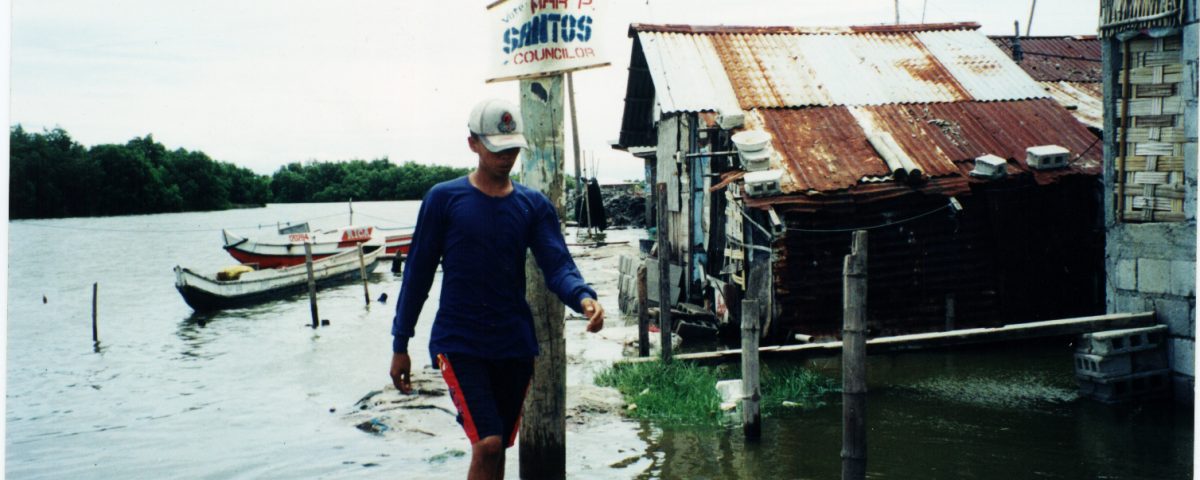THE PARABLE OF THE TEN VIRGINS IN THE 21ST CENTURY

Kumita ka ba?
November 15, 2020
God is Sufficient
November 21, 2020We experienced the flood that various communities are experiencing now in post-Pinatubo Pampanga in the latter part of 1990. I spent half of my life in the town of Lubao, in a barangay named San Nicolas 1st and a purok that residents jokingly call San Palakul because it is shaped like an axe. The lot where our house stood used to be swampland. We grew up in a gated property behind which were fishponds owned by the del Prado family. I remember Ima saying that our property was once owned by the wealthy Arrastia family which produced the likes of Isabel Presyler, ex-wife of singer Julio Iglesias and Mercedes Arrastia-Tuason, former Philippine Ambassador to the Vatican.
As an aside, I felt proud of the fact that this sleepy town west of Pampanga was once home to numerous celebrities and prominent personalities like Rogelio and Jaime dela Rosa, Diosdado Macapagal, Gloria Macapagal-Arroyo, Mario Montenegro, Rudy and Merly Fernandez, etc. I got a kick out of watching them engage in a tete-a-tete at the frontyard of Lubao Central Elementary School after casting their votes during elections. If cellphone cameras were in vogue then, I would have been one of the many who quietly took a selfie with all these celebrities in the background.
There are two flooding events in our town that stand out in my memory. The first was in 1972 and is widely referred to as the “Great Flood of 1972.” Google says it was caused by four typhoons (Edeng, Gloring, Isang, and Huaning) that came in succession between July to August of that year. I was six years old at that time. The water was neck-deep along our street. Our elders shielded us from the hazards by taking us to the house next door— an ancestral house with a second floor that was higher than ours. It was owned by our relatives, the Fajardo-Samaniego family. We watched from afar as the elders boarded bancas to buy supplies not only for humans but for animals. We had a backyard piggery and poultry at that time. Long before the food for work concept came into being, Ima had the habit of taking in neighbors from poor families to work in our backyard farm in exchange for free meals, tuition and allowance for their schooling. I remember seeing some of them taking the pigs to higher ground aboard a balsa – a makeshift boat made of banana trunks that were tied together using abaca rope. At night, one could hear weeping from the stay-in helpers who could not bear the pain caused by alipunga (athlete’s foot). When my Lolo Dadong, a doctor, was not looking, they’d squeeze calamansi onto their wounds in place of anti-fungal ointment then shriek from the pain.
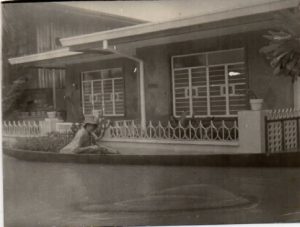
1972 flooding. Boats and balsas were the major modes of transportation then. Photo shows my grandparents’ bungalow. Half of it was submerged in water at the height of the flooding. In 1997, only the roof and the upper portion of the windows were visible.

Neighbors stepping on their balsa while relaxing on the steps of the stairs of their wooden abode. 1972.
When the water subsided a bit, we were allowed to venture out and ride a balsa or a banca once in a while. One time, a helicopter dropped packs of nutribuns while we were out on a banca ride. We quickly retrieved the relief packs, only to find out that molds had grown on some of the buns. We scraped off the molds and ate the edible portion. There was also darak mais (corn bran) which our helpers toasted and which we ate with sugar. It tasted like poor man’s polvoron sans the butter.
For quite some time, the Great Flood of 1972 was the benchmark of disaster in Pampanga. People always referred to it whenever flooding occurred. That was until Mt. Pinatubo erupted in 1991. Following the flow of lahar and siltation of Pampanga’s waterways, flooding became an annual occurrence in Lubao and neighboring towns. Our barangay is right next to Sasmuan, a coastal town with waterways that flow out to the open seas through Manila Bay. Foreign governments sent workers to help dredge the heavily-silted rivers, but no matter how hard they dredged the Pasak River, the floods persisted. Pasak River was legendary as a part of a route taken by huge ships to sail to and from Manila during the Spanish era, earning for it the moniker “Dalan Bapor” (literally ship’s way). I remember how locals described its depth. “Lumbug ya ing kuayan” (in reference to the length of an uncut bamboo trunk that apparently was no match to the river’s depth).
The annual post-eruption flooding occurrences in our barangay varied in severity. One flooding event lasted for three months, covering the road with moss and making it impossible to walk without sliding on the slippery surface. The water had a greenish tinge. We had gotten used to our annual visitor that when monsoon season came, we made all the necessary preparations then went on with our normal lives. My parents asked carpenters to build wooden stands for our appliances. There was no need to rush and call for help whenever the flood level rose.
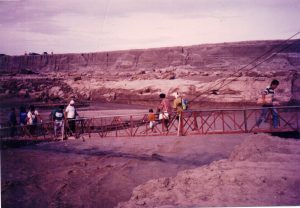
Lahar in Porac after the eruption of Mt. Pinatubo. People had to be creative in finding ways of moving around the province. This makeshift bridge had to be transferred from one place to another as lahar kept scouring its base.
To some, the floods were a boon because damaged dikes from nearby fishponds sent tilapias swimming right into our homes. It was usual to find fully-grown tilapias swimming around the dining room while we were having our meals. Dried tilapia fillet – some seasoned with salt and vinegar, some seasoned with sugar – was regular fare during the rainy season. Sometimes, fully-grown mudfish made splashes in the canal. What I feared most during these floods were the snakes that climbed up the trees then made a sudden dive when somebody passed by. Also the floating human poop that came in various colors, sizes and shapes (eww!). My hair would stand on end every time I waded in the water.
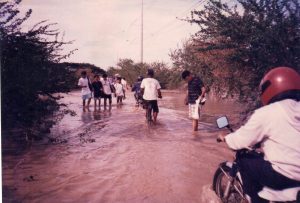
We did not expect the situation to get worse than it already was at that point until in 1997, rains dumped by Typhoon Ibiang caused the breaching of a dike surrounding a river in Sta. Cruz, Lubao. It resulted to massive flooding that surpassed our 1972 experience. It was late in the evening when water rushed into Purok San Palakul. Water hadn’t risen as quickly as this before. When it was clear that this was no ordinary flooding, my family made a move to transfer to my parent’s house which was just a house away from my grandparents’ bungalow where we were staying. That one had a second floor. As we stepped out of the gate, the current almost swept us away. A hero came in the person of our neighbor Alex Marquez who was strong enough to tow a banca amidst the rising and flowing floodwater. He instructed us to hold on to the banca as he and his friends pushed it towards my parents’ home. Most of our neighbors evacuated to the public school in front of our home. We parked our vehicles in the school compound because its grounds were newly-elevated then.
The flood eventually reached the second floor of my parents’ house, forcing us to move to our relatives’ house next door. It was the same structure where we sought refuge twenty five years earlier. Mercifully, as the water level reached the last two steps of the stairs to the second floor, it stopped rising. The sight that greeted us the morning after came as a shock. Only the roofs of our vehicles were visible. My grandparents’ bungalow was almost submerged. Only the roof and the upper half of the windows could be seen. It was like looking at a vast river full of chocolate brown water.
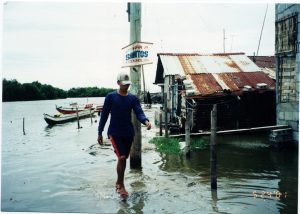
Coping with annual floods has become a way of life for people living in the lower sections of the basin where Pampanga Delta lies. Communities in these areas should not ignore threats of ground subsidence and saltwater intrusion. The threats are imminent. (Photo credit: Pampanga Disaster Risk Reduction Network)
While we were relatively living a comfortable life in our relatives’ home, we had to contend with prolonged brownout, limited water supply and sanitation problems. The pozo negro was submerged, making it impossible to flush the toilet the usual way. In no time at all, fungal infection set in. Athlete’s foot (alipunga) grew on the soles of our feet and Tinea versicolor (an-an) covered the whole of my back. The worst part was that the public had little or no knowledge at all of what was happening in our purok. It was only when then senator Gloria Macapagal-Arroyo came to distribute relief goods aboard an amphibian that people got wind of our situation.
It took weeks for the flood to recede completely. When it did, our homes were a mess. It took more than a month of clearing and cleaning to make them livable again. There were days when I cried while throwing away all the stuff laden with sentimental value but which I had to let go because there was no way of repairing the damage wrought by the floods. I was no longer the child who was shielded from the ugliness of disasters. This time, I was the mother who had to protect my children from harm. Husband and I decided to send them to Mindanao to keep them out of harm’s way as we struggled to put our lives back on track. Shortly thereafter, trauma made us decide to move out of my hometown.
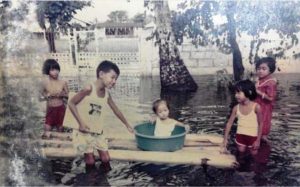
Joyride aboard a balsa in one of the post-Pinatubo flooding events at Purok San Palakul.
These experiences came to mind when I saw the communities affected by floods in the aftermath of the super typhoons that visited the Philippines recently. When this spate of disasters occurred, I thought it imperative to give. Only those with wooden hearts could remain unaffected by all the images of death and destruction. Before I could even get my hands on my earnings for the month, I already pledged half of it for the affected communities. “It is just a drop in the bucket, Lord. I wish I have more to give,” I silently prayed. A voice in my head said, ”It is okay. It will help fill the bucket. If everyone contributed a drop, the bucket would be filled to the brim in no time at all.”
While I was listening to the howling winds as Typhoon Ulysses unleashed its fury over Central Luzon, this same voice in my head was retelling the parable of the ten virgins. It gave the parable a twist:
The bridegroom himself met the five wise virgins by the entrance to the hall. He knew that five of the ten virgins were ill-prepared and had to get some oil to keep their lamps burning. “Sana all,” said the foolish virgins sadly. “Sorry na lang,” replied the five wise virgins as they walked excitedly with the bridegroom. Not one of them noticed the enigmatic look on the bridegroom’s face.
Instead of ushering the wise virgins to the altar for the ceremony, the bridegroom asked them to follow him into a waiting room. He then excused himself and promised to return shortly. A few minutes passed and the bridegroom came back with the five foolish who all looked tired and harassed from all the effort that they had to make to get some oil. Both the wise and the foolish were surprised. They eyed each other curiously. The suspense was killing them. What was the bridegroom up to?
“I watched you through a hidden camera and saw how you treated each other while you were waiting for me. I have decided to postpone the ceremony until all you ten virgins are ready. I want not five but all ten of you to be present. I’ll leave you on your own now. It is up to you to find ways of getting everyone in. No one should be left behind. At that, the bridegroom shut the door behind him. His mysterious smile grew wider.
When this pandemic began, many people saw it as a test of faith. Several disasters later, something tells me that it is more a test of character than a test of faith. It is not a question of ”Do you have faith in me?” but rather ”Do you love me?” It is the same question that Jesus asked Peter. It is followed by a suggestion on how this love can be made tangible: Leave no one behind.

